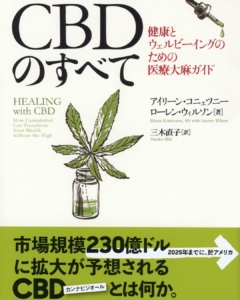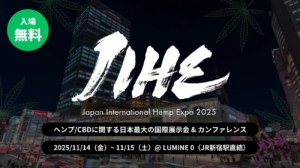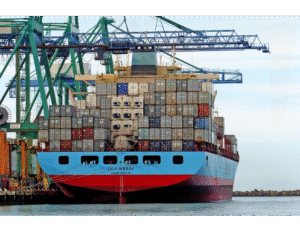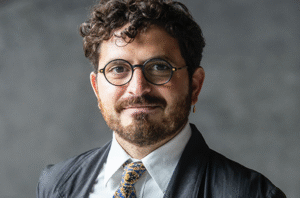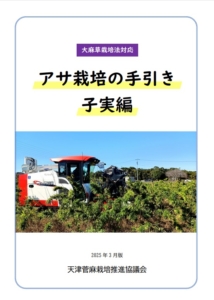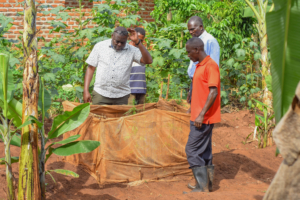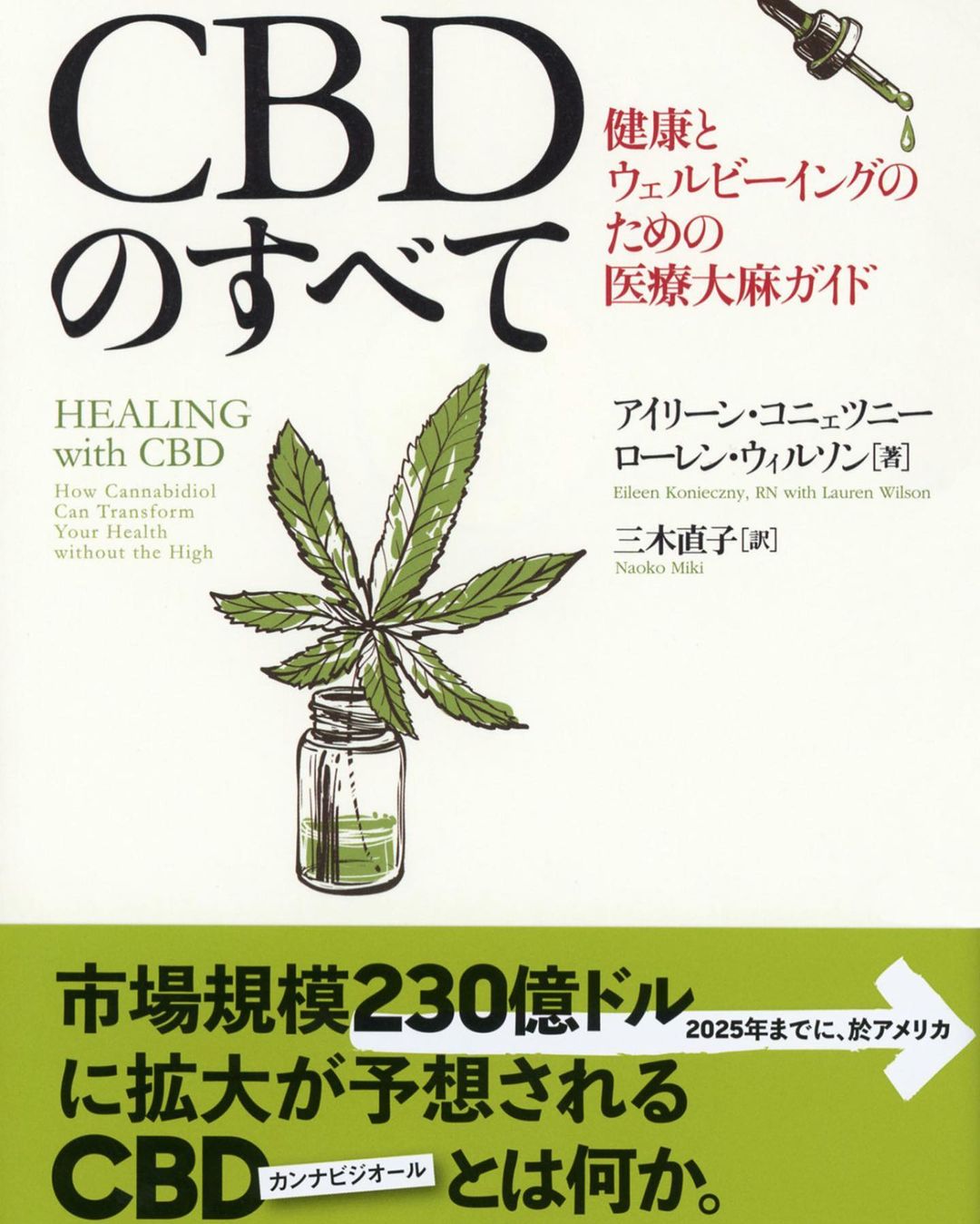
この本は、実際の医療現場で患者に寄り添ってきた看護師が、その経験を踏まえて書いた医療大麻におけるCBDの歴史と作用機序についての様々な科学的な解説から、実際の製品の選び方や使い方までを詳説しているCBDのガイドブックです。
CBDは、日本でも2013年から輸入が開始され、2020年4月には厚生労働省においてもCBD製品の輸入手続きが明確化され、参入業者も120社を超えると言われています。
本記事では、書籍「CBDのすべて」の参考文献一覧がp68に出版社のリンクがあるのですが、WEB上で使いやすくしたので、ご活用下さい。
参考文献で“doi:”とあります。この DOIは、Digital Object Identifierの頭文字で、コンテンツの電子データに付与される国際的な識別子です。この数字をコピー&ペーストして、ブラウザ等に入力するとコンテンツの所在情報(URI)に変換されます。
商品に対するバーコードや、書籍に対するISBNコードと同じで世界的に統一されており、学術論文でよく見られる形式です。実際に本文中の参考文献にアクセスしたい方にはかなり便利なツールとなっています。ぜひ、下記参考文献で気になったものがあればアクセスしてみて下さい。
CBDのすべて 健康とウェルビーイングのための医療大麻ガイド
アイリーン・コニェツニー(著/文)ローレン・ウィルソン(著/文)三木直子(翻訳)
発行:晶文社
四六判328ページ
定価 2,300円+税
初版年月日2019年12月17日
ご注文はこちら https://www.amazon.co.jp/dp/4794971591
目次
第1章:何がそんなにすごいの?
第2章:大麻草の歴史
第3章:エンドカンナビノイド・システム
第4章:カンナビノイドとアントラージュ効果
第5章:カンナビジオール(CBD)って何?
第6章:CBDって安全なの?
第7章:CBDの原材料――大麻草とヘンプ
第8章:CBDと二七の疾患
第9章:あなたに合ったCBDの使い方
第10章:どれくらい摂ったらいいの?
第11章:信頼できる製品をみつけるには
CBDのすべて 健康とウェルビーイングのための医療大麻ガイド参考文献一覧
第2章:大麻草の歴史
[1] Vincenzo Di Marzo and Fabiana Piscitelli, “The Endocannabinoid System and Its Modulation by Phytocannabinoids,” Neurotherapeutics 12, no. 4(2015): 692–98,
doi:10.1007/s13311-015-0374-6.
第3章:エンドカンナビノイド・システム
[2]Daniel R. McDougle et al., “Anti-Inflammatory ω -3 Endocannabinoid Epoxides,” Proceedings of the National Academy of Sciences 114, no. 30(2017), doi:10.1073/pnas.1610325114.
[3]John M. McPartland et al., “Care and Feeding of the Endocannabinoid System: A Systematic
Review of Potential Clinical Interventions That Upregulate the Endocannabinoid System,”
PLoS One 9, no. 3(2014), doi:10.1371/journal.pone.0089566.
[4] McPartland et al., “Care and Feeding.”
[5]Maria Morena et al., “Neurobiological Interactions between Stress and the Endocannabinoid System,” Neuropsychopharmacology 41, no. 1(2016): 80–102, doi:10.1038/npp.2015.166.
[6] Elsa Heyman et al., “Intense Exercise Increases Circulating Endocannabinoid and BDNF Levels in Humans—Possible Implications for Reward and Depression,” Psychoneuroendocrinology 37, no. 6(2012): 844–51, doi:10.1016/j.psyneuen.2011.09.017.
第4章:カンナビノイドとアントラージュ効果
[7] Raymond Niesink et al., “Does Cannabidiol Protect Against Adverse Psychological Effects of THC?”, Frontiers in Psychiatry 4, no.4(2013): 130, doi:10.3389/fpsyt.2013.00130.
[8] J. D. Wilkinson et al., “Medicinal Cannabis: Is Δ9-Tetrahydrocannabinol Necessary for All Its Effects?” Journal of Pharmacy and Pharmacology 55, no. 12(2004): 1687–94, doi:10.1211/0022357022304.
[9] Angélica Maria Sabogal-Guáqueta, Edison Osorio, and Gloria Patricia Cardona-Gómez, “Linalool Reverses Neuropathological and Behavioral Impairments in Old Triple Transgenic Alzheimers Mice,” Neuropharmacology 102,(2016): 111–20, doi:10.1016/ j.neuropharm.2015.11.002.
[10] A. L. Klauke et al., “The Cannabinoid CB2 Receptor-Selective Phytocannabinoid Beta-Caryophyllene Exerts Analgesic Effects in Mouse Models of Inflammatory and Neuropathic Pain,” European Neuropsychopharmacology 24, no. 4(2014): 608–20, doi:10.1016/ j.euroneuro.2013.10.008.
[11] Amine Bahi et al., “ β -Caryophyllene, a CB2 Receptor Agonist Produces Multiple Behavioral Changes Relevant to Anxiety and Depression in Mice,” Physiology & Behavior 135,(2014): 119–24, doi:10.1016/j.physbeh.2014.06.003.
[12] T. G. do Vale et al., “Central Effects of Citral, Myrcene and Limonene, Constituents of Essential Oil Chemotypes from Lippia Alba(Mill.)N.E. Brown,” Phytomedicine 9, no. 8(2002): 709–14.
[13] V. S. Rao, A. M. Menezes, and G. S. Viana, “Effect of Myrcene on Nociception in Mice,”
Journal of Pharmacy and Pharmacology 42, no. 12(1990): 877–78, doi:10.1111/j.2042-
7158.1990.tb07046.x.; L. I. Paula-Freire et al., “Evaluation of the Antinociceptive Activity Of Ocimum GratissimumL.(Lamiaceae)Essential Oil and Its Isolated Active Principles in Mice,” Phytotherapy Research 27, no. 8(2013): 1220–24, doi:10.1002/ptr.4845.
[14] Aline De Moraes Pultrini, Luciane Almeida Galindo, and Mirtes Costa, “Effects of the
Essential Oil from Citrus Aurantium L. in Experimental Anxiety Models in Mice,” Life Sciences 78, no. 15(2006): 1720–25, doi:10.1016/j.lfs.2005.08.004.
[15] C. F. Zhang, Z. L. Yang, and J. B. Luo, “Effects of D-Limonene and L-Limonene on Transdermal Absorption of Ligustrazine Hydrochloride,” Yao Xue Xue Bao 41, no. 8(2006):772–77.
[16] J. Sun, “D-Limonene: Safety and Clinical Applications,” Alternative Medicine Review 12, no. 3(2007): 259–64.
[17] R. L. Jirtle et al., “Increased Mannose 6-Phosphate/Insulin-like Growth Factor II Receptor
and Transforming Growth Factor Beta 1 Levels during Monoterpene-Induced Regression of Mammary Tumors,” Cancer Research 53, no. 17(1993): 3849–52.
[18] M. G. de Oliveira et al., “ α -Terpineol Reduces Mechanical Hypernociception and
Inflammatory Response,” Basic & Clinical Pharmacology & Toxicology 111, no. 2(2012):
120–25, doi:10.1111/j.1742-7843.2012.00875.x.
[19] R. H. L. Souza et al., “Gastroprotective Activity of α -Terpineol in Two Experimental Models of Gastric Ulcer in Rats,” DARU Journal of Pharmaceutical Sciences 19, no. 4(2011):277–81.
[20] Li Li et al., “Antibacterial Activity of a-Terpineol May Induce Morphostructural Alterations in Escherichia Coli,” Brazilian Journal of Microbiology 45, no. 4(2015): 1409–13,
doi:10.1590/s1517-83822014000400035.
[21] J. L. Bicas et al., “Evaluation of the Antioxidant and Antiproliferative Potential of Bioflavors,”
Food and Chemical Toxicology 49, no. 7(2011): 1610–15, doi:10.1016/j.fct.2011.04.012.
第5章:カンナビジオール(CBD)って何?
[22] A. J. Hampson et al., “Cannabidiol and(−)Δ 9-Tetrahydrocannabinol Are Neuroprotective Antioxidants,” Proceedings of the National Academy of Sciences 95, no. 14(1998): 8268–73,
doi:10.1073/pnas.95.14.8268.
第6章:CBDって安全なの?
[23] Kerstin Iffland and Franjo Grotenhermen, “An Update on Safety and Side Effects of Cannabidiol: A Review of Clinical Data and Relevant Animal Studies,” Cannabis and Cannabinoid Research 2, no. 1(2017): 139–54, doi:10.1089/can.2016.0034.
[24] M. M. Bergamaschi et al., “Safety and Side Effects of Cannabidiol, a Cannabis Sativa Constituent,” Current Drug Safety 6, no. 4(2011): 237–49, doi:10.2174/157488611798280924.
[25] Amanda Reiman, Mark Welty, and Perry Solomon, “Cannabis as a Substitute for Opioid-Based Pain Medication: Patient Self-Report,” Cannabis and Cannabinoid Research 2, no. 1
(2017): 160–66, doi:10.1089/can.2017.0012.
[26] Kevin F. Boehnke, Evangelos Litinas, and Daniel J. Clauw, “Medical Cannabis Use Is Associated with Decreased Opiate Medication Use in a Retrospective Cross-Sectional Survey of Patients 252 HEALING with CBD with Chronic Pain,” The Journal of Pain 17, no. 6(2016): 739–44, doi:10.1016/j.jpain.2016.03.002.
[27] Gustavo Gonzalez-Cuevas et al., “Unique Treatment Potential of Cannabidiol for the Prevention of Relapse to Drug Use: Preclinical Proof of Principle,” Neuropsychopharmacology(2018), doi:10.1038/s41386-018-0050-8.
[28] Kerstin Iffland and Franjo Grotenhermen, “An Update on Safety and Side Effects of Cannabidiol: A Review of Clinical Data and Relevant Animal Studies,” Cannabis and Cannabinoid Research 2, no. 1(2017): 139–54, doi:10.1089/can.2016.0034.
第8章:CBDと二七の疾患
依存症
[29] E. L. Gardner, “Endocannabinoid Signaling System and Brain Reward: Emphasis on Dopamine,” Pharmacology Biochemistry and Behavior 81, no. 2(2005): 263–84,
doi:10.1016/j.pbb.2005.01.032.
[30] Daniel Liput et al., “Transdermal Delivery of Cannabidiol Attenuates Binge Alcohol- Induced Neurodegeneration in a Rodent Model of an Alcohol Use Disorder,” Pharmacology Biochemistry and Behavior 111(2013): 120-127, doi:/10.1016/j.pbb.2013.08.013.
[31] Yuping Wang et al., “Cannabidiol Attenuates Alcohol-Induced Liver Steatosis, Metabolic Dysregulation, Inflammation and Neutrophil-Mediated Injury,” Scientific Reports 7, no. 1(2017),
doi:10.1038/s41598-017-10924-8.
[32] Gustavo Gonzalez-Cuevas et al., “Unique Treatment Potential of Cannabidiol for the Prevention of Relapse to Drug Use: Preclinical Proof of Principle,” Neuropsychopharmacology(2018),
doi:10.1038/s41386-018-0050-8.
[33] Chandni Hindocha et al., “Cannabidiol Reverses Attentional Bias to Cigarette Cues in a Human Experimental Model of Tobacco Withdrawal,” Addiction, May(2018), doi:10.1111/add.14243.
[34] Yasmin L. Hurd et al., “Early Phase in the Development of Cannabidiol as a Treatment for Addiction: Opioid Relapse Takes Initial Center Stage,” Neurotherapeutics 12, no. 4(2015): 807–15,
doi:10.1007/s13311-015-0373-7.
[35] Yanhua Ren et al., “Cannabidiol, a Nonpsychotropic Component of Cannabis, Inhibits Cue- Induced Heroin Seeking and Normalizes Discrete Mesolimbic Neuronal Disturbances,” Journal of Neuroscience 29, no. 47(2010): 14764–69, doi:10.1523/jneurosci.4291-09.2009.
筋萎縮性側索硬化症(ALS)
[36] Thangavelu Soundara Rajan et al., “Gingival Stromal Cells as an In Vitro Model: Cannabidiol Modulates Genes Linked with Amyotrophic Lateral Sclerosis,” Journal of Cellular Biochemistry 118, no. 4(2016): 819–28, doi:10.1002/jcb.25757.
[37] Gregory T. Carter et al., “Cannabis and Amyotrophic Lateral Sclerosis: Hypothetical and Practical Applications, and a Call for Clinical Trials,” American Journal of Hospice and Palliative Medicine 27, no. 5(2010): 347–56, doi:10.1177/1049909110369531.
[38] Emanuela Mazzon and Sabrina Giacoppo, “Can Cannabinoids Be a Potential Therapeutic Tool in Amyotrophic Lateral Sclerosis?” Neural Regeneration Research 11, no. 12(2016): 1896–99, doi:10.4103/1673-5374.197125.
[39] Rajan et al., “Gingival Stromal Cells as an In Vitro Model,” 819–28.
ぜんそく
[40] A. Calignano et al., “Bidirectional Control of Airway Responsiveness by Endogenous Cannabinoids,” Nature 408, no. 6808(2000): 96–101.
[41] Sumner Burstein, “Cannabidiol(CBD)and Its Analogs: a Review of Their Effects on Inflammation,” Bioorganic & Medicinal Chemistry 23, no. 7(2015): 1377–85, doi:10.1016/j.bmc.2015.01.059.
[42] Francieli Vuolo et al., “Evaluation of Serum Cytokines Levels and the Role of Cannabidiol Treatment in Animal Model of Asthma,” Mediators of Inflammation 2015,(May 2015). doi:10.1155/2015/538670.
自閉症
[43] C. Földy, R. C. Malenka, and T. C. Südhof, “Autism-Associated Neuroligin-3 Mutations Commonly Disrupt Tonic Endocannabinoid Signaling,” Neuron 78, no. 3(2013): 498–509,
doi:10.1016/j. neuron.2013.02.036.
[44] Dario Siniscalco et al., “Cannabinoid Receptor Type 2, but Not Type 1, Is Up-Regulated in Peripheral Blood Mononuclear Cells of 254 HEALING with CBD Children Affected by Autistic Disorders,” Journal of Autism and Developmental Disorders 43, no. 11(2013): 2686–95, doi:10.1007/s10803-013-1824-9.
[45] V. M. Doenni et al., “Deficient Adolescent Social Behavior Following Early-Life Inflammation Is Ameliorated by Augmentation of Anandamide Signaling,” Brain, Behavior, and Immunity 58(July 2016): 237–47, doi:10.1016/j.bbi.2016.07.152.
アルツハイマー病
[46] Georgia Watt and Tim Karl, “In vivo Evidence for Therapeutic Properties of Cannabidiol(CBD)for Alzheimers Disease,” Frontiers in Pharmacology 8(February 2017): 20,
doi:10.3389/fphar.2017.00020.
[47] A. M. Martín-Moreno et al., “Cannabidiol and Other Cannabinoids Reduce Microglial Activation In Vitro and In Vivo: Relevance to Alzheimers Disease,” Molecular Pharmacology 79, no. 6(2011): 964–73, doi:10.1124/mol.111.071290.
[48] David Cheng et al., “Long-Term Cannabidiol Treatment Prevents the Development of Social Recognition Memory Deficits in Alzheimers Disease Transgenic Mice,” Journal of Alzheimers Disease 42, no. 4(2014): 1383–96, doi:10.3233/jad-140921.
[49] Melanie-Jayne R. Howes and Elaine Perry, “The Role of Phytochemicals in the Treatment and Prevention of Dementia,” Drugs & Aging 28, no. 6(2011): 439–68, doi:10.2165/11591310-000000000-00000.
ADD/ADHD
[50] Peter Strohbeck-Huehner, Gisela Skopp, and Tainer Mattern, “Cannabis Improves Symptoms of ADHD,” Cannabinoids 3, no. 1(2008): 1–3.
[51] Maura Castelli et al., “Loss of Striatal Cannabinoid CB1 Receptor Function in Attention-Deficit/Hyperactivity Disorder Mice with Point-Mutation of the Dopamine Transporter,” European Journal of Neuroscience 43, no. 9(2011): 1369-1377, doi:10.1111/j.1460- 9568.2011.07876.x.
不安神経症
[52] Esther M. Blessing et al., “Cannabidiol as a Potential Treatment for Anxiety Disorders,” Neurotherapeutics 12, no. 4(2015): 825–36, doi:10.1007/s13311-015-0387-1.
[53] Raquel Linge et al., “Cannabidiol Induces Rapid-Acting Antidepressant-like Effects and
Enhances Cortical 5-HT/Glutamate Neurotransmission: Role of 5-HT1A Receptors,” Neuropharmacology 103,(December 2015): 16–26, doi:10.1016/j.neuropharm.2015.12.017.
[54] Alline C. Campos et al., “The Anxiolytic Effect of Cannabidiol on Chronically Stressed Mice Depends on Hippocampal Neurogenesis: Involvement of the Endocannabinoid System,” The International Journal of Neuropsychopharmacology 16, no. 6(2013): 1407–19, doi:10.1017/s1461145712001502.
[55] José Alexandre S. Crippa et al., “Neural Basis of Anxiolytic Effects of Cannabidiol(CBD)in Generalized Social Anxiety Disorder: a Preliminary Report,” Journal of Psychopharmacology 25, no. 1(2010): 121–30, doi:10.1177/0269881110379283.
[56] Mateus M. Bergamaschi et al., “Cannabidiol Reduces the Anxiety Induced by Simulated Public Speaking in Treatment-Naïve Social Phobia Patients,” Neuropsychopharmacology 36, no. 6(2011): 1219–26.
[57] Leonardo B. M. Resstel et al., “5-HT1A Receptors Are Involved in the Cannabidiol-Induced
Attenuation of Behavioural and Cardiovascular Responses to Acute Restraint Stress in Rats,” British Journal of Pharmacology 156, no. 1(2009): 181–88, doi:10.1111/j.1476- 5381.2008.00046.x.
[58] Mark A. Lewis, Ethan B. Russo, and Kevin M. Smith, “Pharmacological Foundations of Cannabis Chemovars,” Planta Medica 84, no. 4(2017): 225–33, doi:10.1055/s-0043-122240.
[59] Ethan B. Russo, “Taming THC: Potential Cannabis Synergy and Phytocannabinoid- Terpenoid Entourage Effects,” British Journal of Pharmacology 163, no. 7(2011): 1344–64,
doi:10.1111/j.1476-5381.2011.01238.x.
関節炎
[60] Sumner Burstein, “Cannabidiol(CBD)and Its Analogs: a Review of Their Effects on Inflammation,” Bioorganic & Medicinal Chemistry 23, no. 7(2015): 1377–85, doi:10.1016/j.bmc.2015.01.059.
[61] Carmen La Porta et al., “Involvement of the Endocannabinoid System in Osteoarthritis Pain,” European Journal of Neuroscience 39, no. 3(2014): 485–500, doi:10.1111/ejn.12468.
[62] D. C. Hammell et al., “Transdermal Cannabidiol Reduces Inflammation and Pain-Related Behaviours in a Rat Model of Arthritis,” European Journal of Pain 20, no. 6(2015): 936–48, doi:10.1002/ejp.818.
[63] A. M. Malfait et al., “The Nonpsychoactive Cannabis Constituent Cannabidiol Is an Oral Anti-Arthritic Therapeutic in Murine Collagen-Induced Arthritis,” Proceedings of the National Academy of Sciences 97, no. 17(2000): 9561–66, doi:10.1073/pnas.160105897.
[64] D. R. Blake et al., “Preliminary Assessment of the Efficacy, Tolerability and Safety of a Cannabis-Based Medicine(Sativex)in the Treatment of Pain Caused by Rheumatoid Arthritis,” Rheumatology 45, no. 1(2005): 50–52, doi:10.1093/rheumatology/kei183.
自己免疫疾患
[65] George W. Booz, “Cannabidiol as an Emergent Therapeutic Strategy for Lessening the
Impact of Inflammation on Oxidative Stress,” Free Radical Biology and Medicine 51, no. 5
(2011): 1054–61, doi:10.1016/j.freeradbiomed.2011.01.007.
[66] P. Pacher, S. Bátkai, and G. Kunos, “The Endocannabinoid System as an Emerging Target of Pharmacotherapy,” Pharmacological Reviews 58, no. 3(2008): 389–462, doi:10.1124/pr.58.3.2.
[67] G. A. Cabral and A. Staab, “Effects on the Immune System,” Handbook of Experimental Pharmacology Cannabinoids, no. 168(2005): 385–423, doi:10.1007/3-540-26573-2_13. [68]Prakash Nagarkatti et al., “Cannabinoids as Novel Anti-Inflammatory Drugs,” Future Medicinal Chemistry 1, no. 7(2009): 1333–49, doi:10.4155/fmc.09.93.
[69] Lola Weiss et al., “Cannabidiol Arrests Onset of Autoimmune Diabetes in NOD Mice,” Neuropharmacology 54, no. 1(2009): 244–49, doi:10.1016/j.neuropharm.2007.06.029.
がん
[70] Paola Massi et al., “Cannabidiol as Potential Anticancer Drug,” British Journal of Clinical Pharmacology 75 no. 2(2013): 303–12, doi:10.1111/j.1365-2125.2012.04298.x.
[71] Massi, “Cannabidiol as Potential Anticancer Drug,” 303–12.
[72] M. Solinas et al., “Cannabidiol Inhibits Angiogenesis by Multiple Mechanisms,” British Journal of Pharmacology 167, no. 6(2012): 1218–31, doi:10.1111/j.1476-5381.2012.02050.x. [73]A.I. Fraguas-Sanchez, A. Fernandez-Carballido, and A.I. Torres-Suarez, “Phyto-, endo-, and synthetic cannabinoids: promising chemotherapeutic agents in the treatment of breast and prostate carcinomas,” Expert Opinion on Investigational Drugs 25, no. 11(2016): 1311- 1323, doi:10.1080/13543784.2016.1236913.
[74] Sean D. McAllister, Liliana Soroceanu, and Pierre-Yves Desprez, “The Antitumor Activity of Plant-Derived Non-Psychoactive Cannabinoids,” Journal of Neuroimmune Pharmacology 10, no. 2(2015): 255–67, doi:10.1007/s11481-015-9608-y.
[75] Katherine Ann Scott et al., “Enhancing the Activity of Cannabidiol and Other Cannabinoids In Vitro Through Modifications to Drug Combinations and Treatment Schedules,” Anticancer Research 33, no. 10(2013): 4373–80.
脳震とう、脳/脊髄損傷
[76] Dereck T. Wade et al., “A Preliminary Controlled Study to Determine Whether Whole-Plant Cannabis Extracts Can Improve Intractable Neurogenic Symptoms,” Clinical Rehabilitation 17, no. 1(2003): 21–29, doi:10.1191/0269215503cr581oa.
[77] Marcelo Kwiatkoski, Francisco Silveira Guimarães, and Elaine Del-Bel, “Cannabidiol-Treated Rats Exhibited Higher Motor Score After Cryogenic Spinal Cord Injury,” Neurotoxicity Research 21, no. 3(2011): 271–80, doi:10.1007/s12640-011-9273-8.
[78] David Fernández-López et al., “Cannabinoids: Well-Suited Candidates for the Treatment of Perinatal Brain Injury,” Brain Sciences 3, no. 3(2013): 1043–59, doi:10.3390/brainsci3031043.
うつ病
[79] Matthew N. Hill et al., “Regional Alterations in the Endocannabinoid System in an Animal Model of Depression: 258 HEALING with CBD Effects of Concurrent Antidepressant Treatment,” Journal of Neurochemistry 106, no. 6(2008): 2322–36, doi:10.1111/j.1471- 4159.2008.05567.x.
[80] Raquel Linge et al., “Cannabidiol Induces Rapid-Acting Antidepressant-like Effects and
Enhances Cortical 5-HT/Glutamate Neurotransmission: Role of 5-HT1A Receptors,” Neuropharmacology 103,(December 2015): 16–26, doi:10.1016/j.neuropharm.2015.12.017.
糖尿病(1型、2型)
[81]Béla Horváth et al., “The Endocannabinoid System and Plant-Derived Cannabinoids in
Diabetes and Diabetic Complications,” The American Journal of Pathology 180, no. 2(2012):432–42, doi:10.1016/j.ajpath.2011.11.003.
[82] Khalid A. Jadoon et al., “Efficacy and Safety of Cannabidiol and Tetrahydrocannabivarin on Glycemic and Lipid Parameters in Patients With Type 2 Diabetes: A Randomized, Double-Blind, Placebo-Controlled, Parallel Group Pilot Study,” Diabetes Care 39, no. 10(2016):1777–86, doi:10.2337/dc16-0650.
[83] Mohanraj Rajesh et al., “Cannabidiol Attenuates High Glucose-Induced Endothelial Cell Inflammatory Response and Barrier Disruption,” American Journal of Physiology-Heart and Circulatory Physiology 293, no. 1(2007): H610–H619, doi:10.1152/ajpheart.00236.2007.
[84] Lola Weiss et al., “Cannabidiol Arrests Onset of Autoimmune Diabetes in NOD Mice,” Neuropharmacology 54, no. 1(2009): 244–49, doi:10.1016/j.neuropharm.2007.06.029.
[85] L. Weiss et al., “Cannabidiol Arrests,” 2006.
[86] Azza B. El-Remessy et al., “Neuroprotective and Blood-Retinal Barrier-Preserving Effects of Cannabidiol in Experimental Diabetes,” The American Journal of Pathology 168, no. 1(2006):235–44, doi:10.2353/ajpath.2006.050500.
線維筋痛症
[87] Brian Walitt et al., “Cannabinoids for Fibromyalgia,” Cochrane Database of Systematic Reviews 7,(July 2016), doi:10.1002/14651858. cd011694.pub2.
[88] George Habib and Suheil Artul, “Medical Cannabis for the Treatment of Fibromyalgia,” JCR: Journal of Clinical Rheumatology 24, no. 5 (2018): 255–58, doi:10.1097/rhu.0000000000000702.
炎症性腸疾患
[89] Angelo A. Izzo and Keith B. Sharkey, “Cannabinoids and the Gut: New Developments and Emerging Concepts,” Pharmacology & Therapeutics 126, no. 1(2010): 21-38, doi:10.1016/j.pharmthera.2009.12.005.
[90] Haidar Shamran et al., “Fatty Acid Amide Hydrolase(FAAH)Blockade Ameliorates Experimental Colitis by Altering MicroRNA Expression and Suppressing Inflammation,” Brain, Behavior, and Immunity 59(June 2016): 10–20, doi:10.1016/j.bbi.2016.06.008.
[91] R. Capasso et al., “Cannabidiol, Extracted From Cannabis sativa, Selectively Inhibits Inflammatory Hypermotility in Mice,” British Journal of Pharmacology 154, no. 5(2008): 1001–8,
doi:10.1038/bjp.2008.177.
[92] Giuseppe Esposito et al., “Cannabidiol in Inflammatory Bowel Diseases: A Brief Overview,” Phytotherapy Research 27, no. 5(2012): 633–36, doi:10.1002/ptr.4781.
[93] J. M. Jamontt et al., “The Effects of Δ 9-Tetrahydrocannabinol and Cannabidiol Alone and in Combination on Damage, Inflammation Andin Vitromotility Disturbances in Rat Colitis,” British Journal of Pharmacology 160, no. 3(2010): 712–23, doi:10.1111/j.1476- 5381.2010.00791.x.
[94] Daniele De Filippis et al., “Cannabidiol Reduces Intestinal Inflammation through the Control of Neuroimmune Axis,” PLoS ONE 6, no. 12(2011), doi:10.1371/journal.pone.0028159.
[95]Ethan B. Russo, “Clinical Endocannabinoid Deficiency(CECD): Can This Concept Explain Therapeutic Benefits of Cannabis in Migraine, Fibromyalgia, Irritable Bowel Syndrome and Other Treatment-Resistant Conditions?” Neuro Endocrinology Letters 29, no. 2(2008): 192–200.
片頭痛
[96] Russo, “Clinical Endocannabinoid Deficiency,” 192–200.
[97] Ethan B. Russo, “Cannabinoids in the Management of Difficult to Treat Pain,” Therapeutics and Clinical Risk Management 4, no. 1(2008): 245–59, doi:10.2147/tcrm.s1928.
[98] Rosaria Greco et al., “Activation of CB2 Receptors as a Potential Therapeutic Target for Migraine: Evaluation in an Animal Model,” The Journal of Headache and Pain 15, no. 1(2014): 14,
doi:10.1186/1129-2377-15-14.
[99] “Cannabinoids Suitable for Migraine Prevention,” EAN, EAN, European Academy of Neurology,(2017)https://www.ean.org/amsterdam2017/fileadmin/user_upload/E-EAN_2017_-_Cannabinoids_in_migraine_-_FINAL.pdf.
多発性硬化症
[100] David Baker et al., “The Biology That Underpins the Therapeutic Potential of Cannabis- Based Medicines for the Control of Spasticity in Multiple Sclerosis,” Multiple Sclerosis and Related Disorders 1, no. 2(2012): 64–75, doi:10.1016/j.msard.2011.11.001.
[101] S. Giacoppo et al., “Purified Cannabidiol, the Main Non-Psychotropic Component of Cannabis Sativa, Alone, Counteracts Neuronal Apoptosis in Experimental Multiple Sclerosis,” European Review for Medical and Pharmacological Sciences 19, no. 24(2015): 4906–19.
[102] Varda Mei-Tal, Sanford Meyerowitz, and George L. Engel, “The Role of Psychological Process in a Somatic Disorder: Multiple Sclerosis,” Psychosomatic Medicine 32, no. 1(1970): 67–86,
doi:10.1097/00006842-197001000-00006.
[103] K. D. Ackerman et al., “Stressful Life Events Precede Exacerbations of Multiple Sclerosis,” Psychosomatic Medicine 64, no. 6(2002): 916–20, doi:10.1097/01.psy.0000038941.33335.40.
悪心/嘔吐
[104] E. M. Rock et al., “Cannabidiol, a Non-Psychotropic Component of Cannabis, Attenuates Vomiting and Nausea-like Behaviour via Indirect Agonism of 5-HT1A Somatodendritic Autoreceptors in the Dorsal Raphe Nucleus,” British Journal of Pharmacology 165, no. 8 (2012): 2620–34,
doi:10.1111/j.1476-5381.2011.01621.x.
[105] E. M. Rock et al., “Cannabinoid Regulation of Acute and Anticipatory Nausea,” Cannabis and Cannabinoid Research 1, no. 1(2016): 113–21, doi:10.1089/can.2016.0006.
[106] D. Bolognini et al., “Cannabidiolic Acid Prevents Vomiting InSuncus Murinusand Nausea-Induced Behaviour in Rats by Enhancing 5-HT1A Receptor Activation,” British Journal of Pharmacology 168, no. 6(2013): 1456–70, doi:10.1111/bph.12043.
[107] L. D. O’Brien et al., “Anandamide Transport Inhibition by ARN272 Attenuates Nausea-Induced Behaviour in Rats, and Vomiting in Shrews(Suncus Murinus),” British Journal of Pharmacology 170, no. 5(2013): 1130–36, doi:10.1111/bph.12360.
肥満
[108] Hilal Ahmad Parray and Jong Won Yun, “Cannabidiol Promotes Browning in 3T3-L1 Adipocytes,” Molecular and Cellular Biochemistry 416, no. 1–2(2016): 131–39, doi:10.1007/s11010-016-2702-5.
パーキンソン病
[109] Itay Lotan et al., “Cannabis(Medical Marijuana)Treatment for Motor and Non–Motor Symptoms of Parkinson Disease,” Clinical Neuropharmacology 37, no. 2(2014): 41–44,
doi:10.1097/wnf.0000000000000016.
[110] Sandeep Vasant More and Dong-Kug Choi, “Promising Cannabinoid-Based Therapies for Parkinson’s Disease: Motor Symptoms to Neuroprotection,” Molecular Neurodegeneration 10,(April 2015): 17, doi:10.1186/s13024-015-0012-0.
[111] Sandeep Vasant More and Dong-Kug Choi, “Emerging Preclinical Pharmacological Targets for Parkinson’s Disease,” Oncotarget 7, no. 20(2016): 29835–63, doi:10.18632/oncotarget.8104.
[112] Marcos Hortes N. Chagas et al., “Effects of Cannabidiol in the Treatment of Patients with Parkinson’s Disease: An Exploratory Double-Blind Trial,” Journal of Psychopharmacology 28, no. 11(2014): 1088–98, doi:10.1177/0269881114550355.
[113] Teresa Iuvone et al, “Cannabidiol: A Promising Drug for Neurodegenerative Disorders?” CNS Neuroscience & Therapeutics 15, no. 1(2009): 65-75, doi: 10.1111/j.1755-5949.2008.00065.x.
疼痛
[114] Rosaria Greco et al., “The Endocannabinoid System and Migraine,” Experimental Neurology 224, no. 1(2010): 85–91, doi:10.1016/j.expneurol.2010.03.029.
[115] Ethan B. Russo, “Cannabinoids in the Management of Difficult to Treat Pain,” Therapeutics and Clinical Risk Management 4, no. 1(2008): 245–59, doi:10.2147/tcrm.s1928.
[116] Kevin F. Boehnke, Evangelos Litinas, and Daniel J. Clauw, “Medical Cannabis Use Is Associated with Decreased Opiate Medication Use in a Retrospective Cross-Sectional Survey of Patients with Chronic Pain,” The Journal of Pain 17, no. 6(2016): 739–44, doi:10.1016/ j.jpain.2016.03.002.
[117] Ethan B. Russo and Andrea G Hohmann, “Role of Cannabinoids in Pain Management,” Essay, In Treatment of Chronic Pain by Medical Approaches,(2013): 181–97. New York,NY: Springer.
[118] Jeremy R. Johnson et al., “Multicenter, Double-Blind, Randomized, Placebo-Controlled, Parallel-Group Study of the Efficacy, Safety, and Tolerability of THC:CBD Extract and THC Extract in Patients with Intractable Cancer-Related Pain,” Journal of Pain and Symptom Management 39, no. 2(2009): 167–79, doi:10.1016/j. jpainsymman.2009.06.008.
ニューロパチー
[119] D. I. Abrams and M. Guzman, “Cannabis in Cancer Care,” Clinical Pharmacology and Therapeutics 97, no. 6(2015): 575–86, doi:0.1002/cpt.108.
心的外傷後ストレス障害(PTSD)
[120] Jonathan L. C. Lee et al., “Cannabidiol Regulation of Emotion and Emotional Memory Processing: Relevance for Treating Anxiety-Related and Substance Abuse Disorders,” British Journal of Pharmacology 174, no. 19(2017): 3242–56, doi:10.1111/bph.13724.
[121] Chenchen Song, et al., “Bidirectional Effects of Cannabidiol on Contextual Fear Memory Extinction,” Frontiers in Pharmacology 16, no. 7(2016), doi:10.3389/fphar.2016.00493.
[122] Matthew N. Hill et al., “Reductions in Circulating Endocannabinoid Levels in Individuals with Post-Traumatic Stress Disorder Following Exposure to the World Trade Center Attacks,” Psychoneuroendocrinology 38, no. 12(2013): 2952–61, doi:10.1016/j.psyneuen.2013.08.004.
統合失調症
[123]Tabitha A. Iseger and Matthijs G. Bossong, “A Systematic Review of the Antipsychotic Properties of Cannabidiol in Humans,” Schizophrenia Research 162, no. 1–3(2015): 153–61, doi:10.1016/j.schres.2015.01.033.
[124]A.W. Zuardi et al., “Cannabidiol, a Cannabis Sativa Constituent, as an Antipsychotic Drug,” Brazilian Journal of Medical and Biological Research 39, no. 4(2006): 421–29, doi:10.1590/s0100-879×2006000400001.
発作性疾患(てんかん症候群)
[125] Ethan B. Russo, “Clinical Endocannabinoid Deficiency(CECD): Can This Concept Explain Therapeutic Benefits of Cannabis in Migraine, Fibromyalgia, Irritable Bowel Syndrome and Other Treatment-Resistant Conditions?” Neuro Endocrinology Letters 25, no. 1–2(2004): 31–39.
[126] Chung Mo Koo and Hoon-Chul Kang, “Could Cannabidiol Be a Treatment Option for Intractable Childhood and Adolescent Epilepsy?” Journal of Epilepsy Research 7, no. 1(2017): 16–20, doi:10.14581/jer.17003.
[127] Margaret Gedde and Edward Maa, “Whole Cannabis Extract of High Concentration Cannabidiol May Calm Seizures in Highly Refractory Pediatric Epilepsies,” Realm of Caring, Realm of Caring Foundation, March 2, 2016, https://www.theroc.us/gedde-study.
[128] Shaun A. Hussain et al., “Perceived Efficacy of Cannabidiol-Enriched Cannabis Extracts for Treatment of Pediatric Epilepsy: A Potential Role for Infantile Spasms and Lennox–Gastaut Syndrome,” Epilepsy & Behavior 47,(April 2015): 138–41, doi:10.1016/j.yebeh.2015.04.009.
[129] Emma H. Kaplan et al., “Cannabidiol Treatment for Refractory Seizures in Sturge-Weber Syndrome,” Pediatric Neurology 71,(June 2017): 18–23, doi:10.1016/j.pediatrneurol.2017.02.009.
[130] Evan C. Rosenberg Pabitra H. Patra, and Benjamin J. Whalley, “Therapeutic Effects of Cannabinoids in Animal Models of Seizures, Epilepsy, Epileptogenesis, and Epilepsy- Related Neuroprotection,” Epilepsy & Behavior 70, Pt B(2017): 319–27, doi:10.1016/ j.yebeh.2016.11.006.
皮膚病
[131] Thomas W. Klein and Catherine A. Newton, “Therapeutic Potential of Cannabinoid-Based Drugs,” Advances in Experimental Medicine and Biology Immune-Mediated Diseases 601(2007): 395–413, doi:10.1007/978-0-387-72005-0_43.
[132] M. Karsak et al., “Attenuation of Allergic Contact Dermatitis Through the Endocannabinoid System,” Science 316, no. 5830(2007): 1494–97, doi:10.1126/science.1142265.
[133] Attila Oláh et al., “Cannabidiol Exerts Sebostatic and Antiinflammatory Effects on Human Sebocytes,” Journal of Clinical Investigation 124, no. 9(2014): 3713–24, doi:10.1172/jci64628.
[134] Ethan B. Russo, “Clinical Endocannabinoid Deficiency Reconsidered: Current Research Supports the Theory in Migraine, Fibromyalgia, Irritable Bowel, and Other Treatment- Resistant Syndromes,” Cannabis and Cannabinoid Research 1, no. 1(2016): 154–65, doi:10.1089/can.2016.0009.
[135] Jonathan D. Wilkinson and Elizabeth M. Williamson, “Cannabinoids Inhibit Human Keratinocyte Proliferation through a Non-CB1/CB2 Mechanism and Have a Potential Therapeutic Value in the Treatment of Psoriasis,” Journal of Dermatological Science 45, no. 2(2006): 87–92, doi:10.1016/j.jdermsci.2006.10.009.
睡眠障害
[136] Daniel F. Kripke, “Hypnotic Drug Risks of Mortality, Infection, Depression, and Cancer: but Lack of Benefit,” F1000Research 5,(May 2016): 918, doi:10.12688/f1000research.8729.1.
[137] Ethan B. Russo, “Cannabidiol Claims and Misconceptions,” Trends in Pharmacological Sciences 38, no. 3(2017): 198–201, doi:10.1016/j.tips.2016.12.004.
[138] Elisaldo A. Carlini and Jomar M. Cunha, “Hypnotic and Antiepileptic Effects of Cannabidiol,” The Journal of Clinical Pharmacology 21, S1(1981), doi:10.1002/j.1552-4604.1981.tb02622.x.
第9章:あなたに合ったCBDの使い方
[139] Atheer Zgair et al., “Dietary Fats and Pharmaceutical Lipid Excipients Increase Systemic Exposure to Orally Administered Cannabis and Cannabis-Based Medicines,” American Journal of Translational Research 8, no. 8(2016): 3448–59.
[140]A. Hazekamp and J. T. Fischedick, “Cannabis—from Cultivar to Chemovar,” Drug Testing and Analysis 4, no. 7–8(2012): 660–67. doi:10.1002/dta.407.
[141]G. C. Ceschel et al., “In Vitro Permeation through Porcine Buccal Mucosa of Salvia Desoleana Atzei & Picci Essential Oil from Topical Formulations,” International Journal of Pharmaceutics 195, no. 1–2(2000): 171–77, doi:10.1016/s0378-5173(99)00381-6.
[142] Attila Olah et al., “Cannabidiol Exerts Sebostatic and Antiinflammatory Effects on Human Sebocytes,” Journal of Clinical Investigation 124, no. 9(2014): 3713–24, doi:10.1172/jci64628.
[143] M. Jamontt et al., “The Effects of Δ 9-Tetrahydrocannabinol and Cannabidiol Alone and in Combination on Damage, Inflammation Andin Vitromotility Disturbances in Rat Colitis,” British Journal of Pharmacology 160, no. 3(2010): 712–23, doi:10.1111/j.1476- 5381.2010.00791.x
第10章:どれくらい摂ったらいいの?
[144] Dustin Sulak, Russell Saneto, and Bonni Goldstein, “The Current Status of Artisanal Cannabis for the Treatment of Epilepsy in the United States,” Epilepsy & Behavior 70, Pt B
(2017): 328–33, doi:10.1016/j.yebeh.2016.12.032.
[145] Deepak Cyril D’Souza et al., “Rapid Changes in Cannabinoid 1 Receptor Availability
in Cannabis-Dependent Male Subjects After Abstinence From Cannabis,” Biological Psychiatry: Cognitive Neuroscience and Neuroimaging 1, no. 1(2016): 60–67, doi:10.1016/j.bpsc.2015.09.008.



